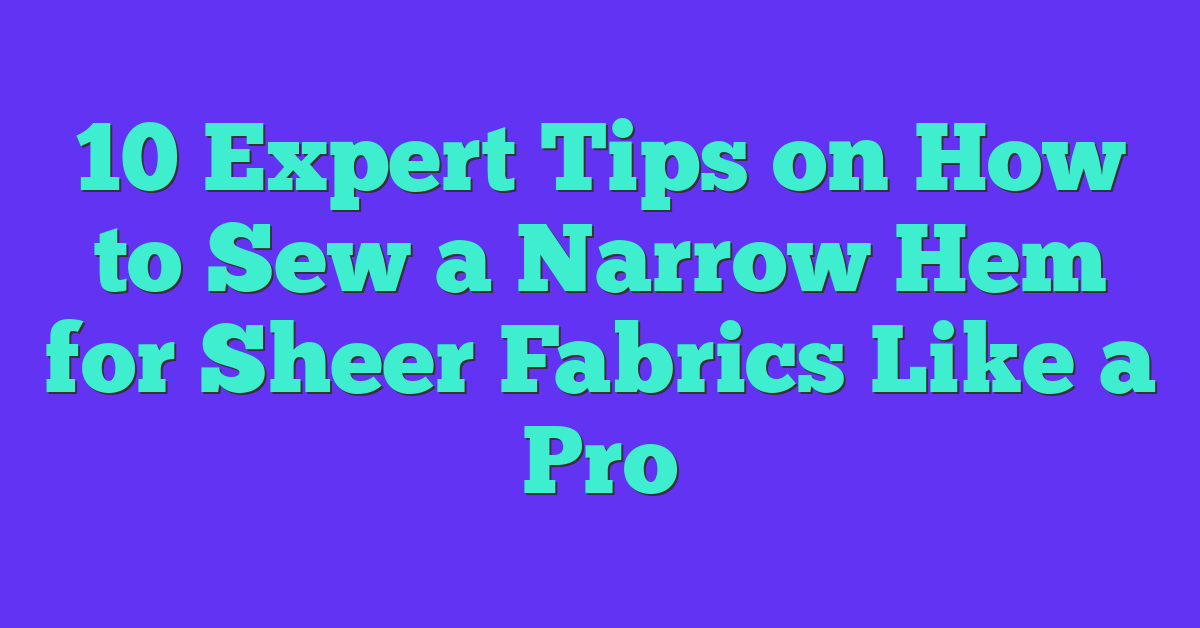Working with sheer fabrics can be both exciting and challenging. I’ve often found that achieving a perfect narrow hem on these delicate materials requires a bit of finesse. Whether you’re a seasoned sewist or just starting out, mastering this technique can elevate your projects beautifully.
In this guide, I’ll walk you through the steps to sew a crisp narrow hem that complements the lightweight nature of sheer fabrics. From selecting the right tools to applying precise stitching, you’ll gain the confidence to tackle your next sewing project with ease.
Understanding Sheer Fabrics
Sheer fabrics require careful handling to achieve a flawless narrow hem. Understanding their characteristics ensures successful sewing outcomes.
Types of Sheer Fabrics
- Chiffon: Lightweight and semi-transparent, ideal for elegant garments.
- Organza: Stiff and crisp, perfect for structured designs and overlays.
- Voile: Soft and breathable, commonly used for summer clothing.
- Tulle: Net-like and very sheer, often used in bridal wear and tutus.
- Georgette: Slightly textured with a drape similar to chiffon, suitable for dresses and blouses.
Properties to Consider
- Weight: Determines the fabric’s drape and ease of handling during hemming.
- Transparency: Affects the visibility of stitches and hem lines.
- Drape: Influences how the fabric hangs, impacting the hem’s appearance.
- Thread Count: Higher counts provide strength, preventing fraying.
- Care Instructions: Guides appropriate hemming techniques and maintenance.
Tools and Materials Needed
To sew a narrow hem for sheer fabrics, gather the right tools and materials. These essentials ensure precision and ease throughout the process.
Essential Sewing Tools
- Sewing Machine: Choose a machine with a straight stitch option and a fine needle to handle delicate, sheer fabrics smoothly.
- Needles: Use size 60/8 or 70/10 microtex needles to prevent snags and ensure clean stitching on lightweight materials.
- Pins and Pin Cushion: Fine pins keep fabric layers aligned without leaving visible marks, making pinning easier and more accurate.
- Measuring Tape: Accurate measurements help achieve an even hem, essential for maintaining the garment’s integrity.
- Iron and Ironing Board: Pressing the fabric before stitching ensures a crisp hem, while pressing afterward sets the stitches neatly.
- Seam Ripper: Quickly correct any stitching errors, maintaining the overall quality of your hem without damaging the fabric.
Recommended Threads
- Polyester Thread: Offers durability and slight elasticity, making it suitable for most sheer fabrics like chiffon and organza.
- Silk Thread: Provides a subtle sheen and strong hold, ideal for luxurious sheers such as georgette and voile.
- Nylon Thread: Best for very lightweight materials, preventing thread breaks and ensuring smooth, invisible seams.
- Color-Matching Threads: Select threads that blend seamlessly with your fabric to maintain the sheer appearance and enhance the hem’s subtlety.
Step-by-Step Guide to Sewing a Narrow Hem
Sewing a narrow hem on sheer fabrics requires precision and the right techniques. Follow these steps to achieve a flawless finish.
Preparing the Fabric
Begin by washing and ironing your fabric to remove any wrinkles or sizing. Lay the fabric flat on a clean surface, ensuring it’s smooth and free of creases. Use fine pins to secure the fabric, placing them perpendicular to the edge to prevent shifting during stitching. Choosing the correct needle, such as a fine microtex needle, is crucial to avoid snags and maintain the fabric’s delicate appearance.
Measuring and Marking the Hem
Accurate measurements ensure a consistent hem. Measure ½ inch from the fabric edge using a clear ruler or measuring tape. Mark this line with lightweight fabric chalk or a disappearing fabric pencil. Repeat the measurement along the entire edge to maintain uniformity. For curved edges, use a flexible measuring tool to follow the fabric’s contour precisely.
Sewing Techniques for Sheer Fabrics
Use a straight stitch on a sewing machine set to a high stitch count for tight, even stitches. Start by sewing a baseline stitch about ¼ inch above the marked line. Then, create a second row of stitches ¼ inch below the baseline to form the narrow hem. Use a fine thread that matches the fabric color to keep the hem discreet. Press the hem with a warm iron, applying gentle steam to set the stitches without damaging the fabric. If necessary, use a walking foot to ensure even feed and prevent puckering.
Tips for a Professional Finish
Achieving a professional finish requires precision and the right techniques. Follow these tips to ensure your narrow hem on sheer fabrics looks impeccable.
Preventing Fabric Stretch
Sheer fabrics like chiffon and voile can stretch easily, causing uneven hems. Use a fine needle, such as a microtex, to reduce stress on the fabric. Stabilize the material with tissue paper or a lightweight stabilizer while stitching. Sew at a slower pace to maintain control and prevent distortion. Press the hem gently with a warm iron to preserve its shape and avoid stretching.
Achieving a Seamless Hem
For a seamless hem, match your thread color exactly to the fabric. Opt for a high stitch count to secure the hem without adding bulk. Fold the hem inward from the wrong side and press it to hide stitching lines effectively. Utilize a walking foot to ensure even fabric feeding and prevent puckering. Test your stitch settings on a scrap piece to adjust tension before working on the actual garment, ensuring a smooth and flawless finish.
Common Mistakes to Avoid
- Using the Wrong Needle: Selecting a regular needle can snag sheer fabrics. Instead, opt for a fine microtex needle to ensure smooth stitching.
- Incorrect Hem Measurement: Measuring the hem inaccurately leads to uneven edges. Always double-check your measurements with a reliable tape measure before sewing.
- Sewing Too Quickly: High sewing speed causes puckering and uneven stitches. Slow down to maintain control and precision during the hem process.
- Choosing Improper Thread: Thick or mismatched threads disrupt the sheer appearance. Select a lightweight, color-matched thread like polyester or silk for the best results.
- Neglecting Fabric Stabilization: Skipping stabilizers allows the fabric to stretch and distort. Use a stabilizer or interfacing to keep the fabric in place while stitching.
- Inadequate Pressing: Pressing the hem with too much heat can weaken the fabric. Use a warm iron and press gently to maintain the fabric’s integrity and shape.
Conclusion
I’m excited for you to try sewing narrow hems on your sheer fabrics With the right tools and techniques you can achieve beautiful, professional results
Take your time and enjoy the process Each project is a chance to refine your skills and express your creativity Don’t worry if it doesn’t come out perfectly the first few times
Keep practicing and experimenting You’ll soon find that working with sheer fabrics becomes second nature Your dedication will make all the difference Happy sewing!


















